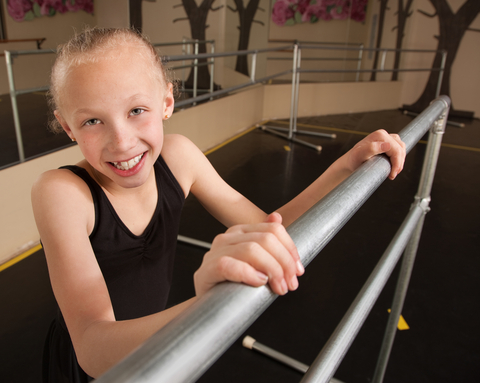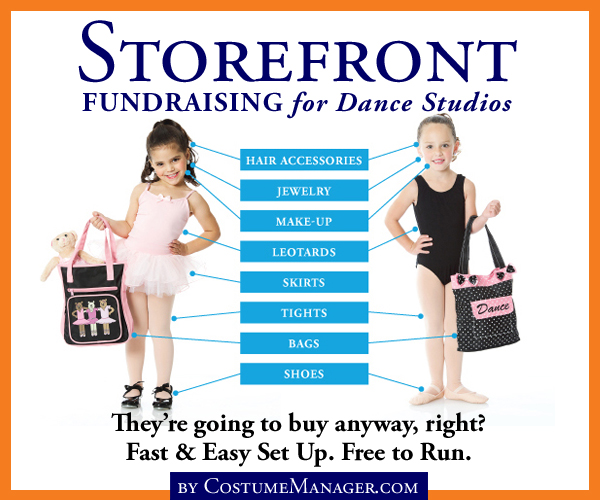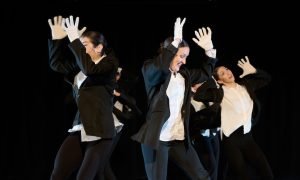By Paul Henderson.
The biggest “aha moment” for my dance studio happened in 2006 when I noticed that our students never came to class naked.
In all my years as the son of a dance studio owner, the brother of dancers, the manager of a dancewear retail store, the husband of a dance studio owner and as the owner of seven dance studios with over 3,500 students, not once have I seen a dancer naked in class. Not only that, but for the most part, all dancers seem to also be wearing shoes in class! They also clog up the hallway with dance bags stuffed with apparel, hats and accessories. The stuff is EVERYWHERE! The lost and found department in my studio is overflowing with ballet shoes, sweaters, jackets, warm-ups, pants (not sure why pants are in there) and various electronic devices left mostly by siblings.
Dancers buy stuff. They buy lots of stuff. They wear the stuff. They lose the stuff, or grow out of it, and then they buy it again and again and again…for years.
Back in 2006, when a potential student’s parents would call in to inquire about our classes, I was the one answering the studio’s office phone. Once I registered them, they always asked me the following question: “What should she wear to class?” When I say “always,” I mean ALWAYS. Not once did a student register for class where the parent just assumed they could wear whatever they wanted to class.
When a client or customer of yours asks what they should wear to class, it is your opportunity (dare I say obligation) to earn the equivalent profit of an extra month and a half of tuition per season. Let me say that again… earn the equivalent profit of an extra month and a half of tuition. At our studios, we’ve figured out how to earn approximately $100 extra profit per dancer, per class, per season.
Before I explain how I did it, I’ll give you a brief history lesson of how I know this. In 1997, I was filling in for my mother at her dancewear store. I went from the U.S. Navy to fitting pointe shoes in the blink of an eye. I learned that the retail dancewear business is horrid – mostly because the inventory simply does not turn over fast enough. That means that you have to buy a lot of inventory and then it mostly sells only twice a year (for back to school and recital.) In comparison, a well-known retail store called Gap turns over its entire inventory every 45 days! For a retail dancewear store, the cost of carrying so much inventory is high, which means profits are low or non-existent.
Dancers came to our store in droves, but only in September and May. For the rest of the months, I occupied my time by creating a website to sell off our vast pointe shoe inventory. That was in 1997, before the Internet was such a huge part of our lives. It was called Getpointe.com and it still exists today; although, I don’t own it anymore.
Fast-forward to 2006 and my wife’s studio in Northern California had exploded from 300 students to nearly 800, and she was completely overwhelmed. I was the Director of Sales for a software company that sold management software to dentists.
My experience in dance retail taught me that I could earn a profit selling dancewear to my own studio’s dancers if I opened a small boutique in my studio and sold only the basics…the dress code. I quit my sales job and started selling dancewear again. But, again, inventory eventually crushed me.
Inventory equals death, as far as I’m concerned. It’s a toxic line item on the balance sheet. I don’t like it. It wastes space. It costs real money. It never goes away completely. [Note: Inventory can go away if you run a “sale,” but the “sale” cannibalizes your future sales to your dancers.]
Before too long, studio-run dance boutiques have hundreds of pairs of tights in various odd sizes and colors that they don’t need, leotards that went out of style with the first iPod, shoe boxes covered in a nice, thick layer of dust and booty shorts stuffed into drawers and boxes on sad, drooping shelves.
Sure, there are companies that will sell dance products to your studio on an “as-needed” basis, but the critical flaw is that you have to pay in advance and they don’t take returns. They offer deals on shipping costs if you order a certain number of items. It’s a trap! The natural inclination is to order extra to lower cost and save money on shipping, but the end result is excess inventory that won’t ever go away. Inventory is money. Inventory is your money sitting on a sad, dusty, drooping shelf. It’s your money that could be used for a dozen other things… like marketing, fresh paint under the barres or a raise for your office manager.
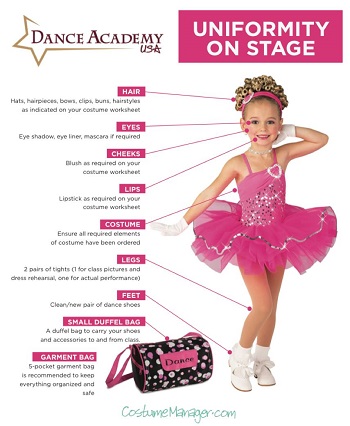
This picture illustrates all of the products a dancer needs just to get on stage for a performance. Why not help your dancer buy these products and help your bottom line at the same time?
There are other dancewear companies that will allow you to create lists of products for your students to buy online, but they only give you a tiny percentage of the sale in store credit or a smaller percentage in cash. In short, it’s not worth the hassle unless you can set the price and control your profit margin.
Still, I thought, these dancers are spending a couple hundred dollars of their parent’s hard-earned money every season for each class. They are buying at least two pairs of shoes, two leotards, 4-5 pairs of tights, skirts, pants, shorts, hair-accessories, make-up, jewelry, costumes and headpieces. The list goes on and on and on. Yet, the studio owner who “owns” these customers is not earning a penny on their purchases. Why is that? Without the studio owner, there would be no dancers. The studio owner is the gateway to the student. The studio owner has immense power, yet they mostly do not wield their power. Why?
There are a lot of reasons, but these three stand out. First, studio owners opened their business because they wanted to teach kids how to dance. They are focused on earning their revenue through tuition. Secondly, the studio owner quickly becomes overwhelmed with the amount of administrative duties a dance studio requires and is reluctant to take on another project. Thirdly, and most importantly, studio owners are afraid. They are afraid of that one parent who complains about everything. Fear is a big motivator and it prevents studios from reaching their full potential.
I wanted to prove to studio owners that their fear was unfounded.
I commissioned two separate surveys of over 650 parents of dancers located all over the United States and Canada. The results were virtually identical so I’ll include results from one of the surveys below.
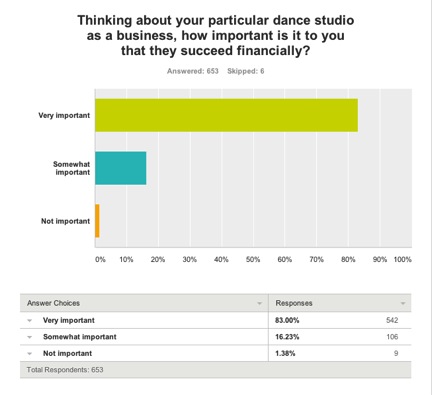
The take-away from this question is that 98.62% of respondents think it is important for your studio to succeed financially. I’ll bet that’s shocking to you. It means if you have 200 families at your studio, only three of them will complain, but you know these three. They already complain about everything anyway, right? Get over it and focus on the 197 other families that want you to succeed.
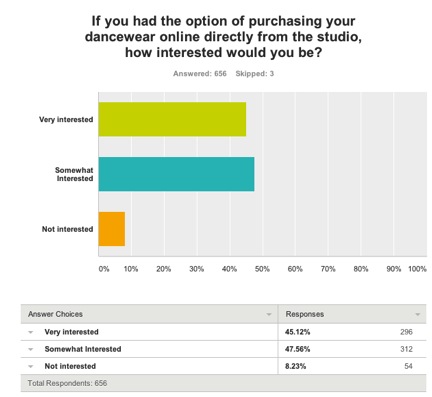
This question prepares the survey taker for the next question. It is meant to start them thinking about what they buy and how. Note that 92% of the respondents are interested in buying from you or your website.
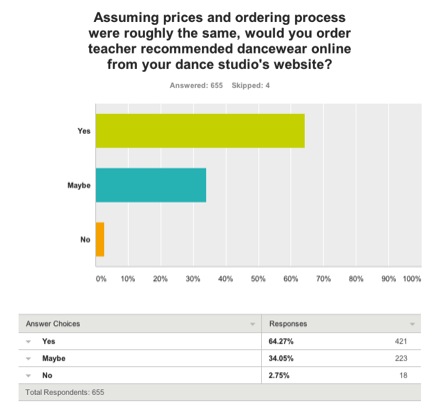
Roughly 97% of your customers would be interested in buying dancewear directly from you. If you have 200 families at your studio, 194 would buy what you tell them to buy from your website. I’ll put it another way… if you could profit $100 per dancer per season that would equal pure profit of $19,400 in a season. What would you do with $19,400?
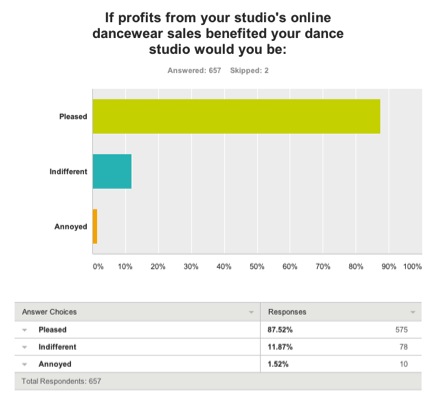
I wanted to prove that studio owners’ fear of customers not wanting them to be profitable was unfounded. Here is the proof. Less than 2% of your customers will be annoyed if they know you are profiting on the sale of dancewear. Why? I believe that most customers want the small, local business that they entrust with their child’s dance education to be financially stable. They would rather the profits benefit you and their local community rather than a large national corporation to which they have no ties. If you explain to your dancers that a percentage of their purchases benefit the studio, 197 out of 200 will be okay with it. It’s nothing to hide.
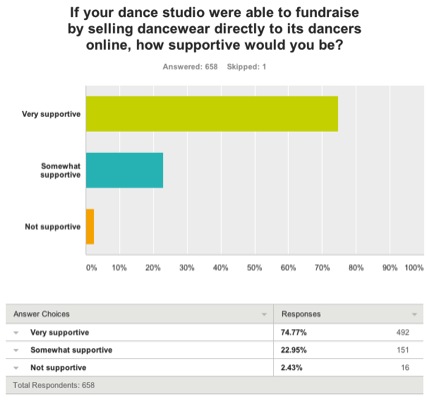
I introduced the word “fundraise” here because one way for a studio to explain “profit” is to call it a “fundraiser” for the studio. It’s just an option. If you made the dress code and accessory product sales to your dancers a fundraiser, 195 out of 200 customers would be supportive.
That’s incredible!
So, figure out how to implement a dress code. Figure out everything that a dancer needs to wear in an entire season. Make the dress code required. Call it a fundraiser if you want. Call it a “new paint” or “new ballet barre” or “master class” or “National Competition” fundraiser. It doesn’t make a difference as long as the customer sees that the studio looks nice, has great instructors and runs smoothly.
Start wielding your immense power today. Remember, without you there are no dancers.
If you want to earn $100 per student, per season, per class use CostumeManager.com’s Storefront. Do it now or you’ll miss out on one of the most amazing benefits of owning a dance studio.

Paul Henderson
About Paul Henderson
Paul Henderson is an expert on administrative technologies for the dance industry and has been around the business for almost 30 years. His sisters were elite state champion gymnasts and dancers and his mother owned a dance studio and eventually a dancewear store. He managed the dancewear store for a few years before moving to the San Francisco Bay Area. He and his wife, Tiffany, currently own and operate Twinkle Star Dance™ – an online choreography and curriculum system for recreational dancers ages 2-11; seven successful dance studios in Northern California (www.tiffanydance.com) and one in Southern California. Tiffany’s Dance Academy’s annual enrollment of over 4,500 students caused Paul to invent ways to automate most of the day-to-day business transactions that take up so much of a studio owner/instructor’s time. Paul’s goal has always been to smooth out the business side of the dance studios so that his wife can spend more time in the studio doing what she loves…teaching. Automating online registration and monthly automatic tuition payments was achieved eight years ago but perhaps the most revolutionary invention is his web-based application – CostumeManager.com.
About CostumeManager.com
For the past six years, Paul Henderson has worked tirelessly with most of the major costume and dancewear manufacturers to consolidate their catalogs into one searchable website. Developing relationships with these companies has been crucial to the success of CostumeManager.com and his efforts have paid off for studios all across the United States and Canada. By creating one searchable website, it is possible for a studio owner to browse all catalogs simultaneously, assign items that they like to a dance class, establish their profit margin, create an online store or print a color worksheet for dancers explaining how they can order their required and or/optional items online or via toll free telephone. Dancers purchase their items securely online and CostumeManager.com orders, receives, sorts and ships the individually packaged items to the studio owner. The studio owner or instructor cashes their “commission” check, hands the bags of goods to the dancer and goes back to teaching. CostumeManager.com eliminates 90% of the work and all the worry associated with distributing costumes and dancewear to dancers while preserving all of the profit margin…if not more.
To connect with Paul Henderson and CostumeManager visit www.CostumeManager.com, www.TwinkleStarDance.com, or www.TiffanyDance.com.


